Grotte d’Azé
Useful Information
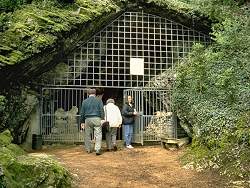

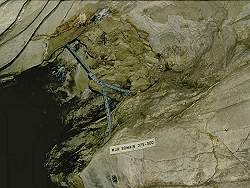
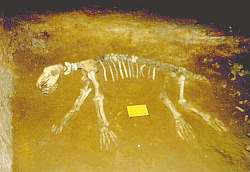
 cave bear found in the Entrance hall.
cave bear found in the Entrance hall.| Location: |
135 route de Donzy, 71260 Azé.
At Azé village. From north Motorway Lyon-Marseille, exit Tournus, through Ozenay, Chardonnay, Lugny, S. Gengoux to Azé, signposted. From south Motorway Lyon-Marseille, exit Macon Nord, through Verchizeuil and Ige to Azé. Fromn Azé D15 Route de Donzy, (46.4392078, 4.7621151) |
| Open: |
06-APR to JUN Mon-Fri 10:30, 14:30, Sat, Sun 10:30, 14:30, 16:30. JUL to AUG daily 10-19. SEP to 03-NOV Mon-Fri 10:30, 14:30, Sat, Sun 10:30, 14:30, 16:30. Online booking mandatory. [2024] |
| Fee: |
Adults EUR 8, Children (6-17) EUR 4.50, Children (0-5) free, Students EUR 5, Family (2+2) 20. [2024] |
| Classification: |
 Karst Cave Karst Cave
|
| Light: |
 LED LED
|
| Dimension: |
T=11 °C, A=275 m asl. Source de la Balme de Rizerolles: L=1,256 m, VR=17 m. Grotte de la balme de Rochebin: L=436 m, VR=22 m. |
| Guided tours: |
D=90 min, L=2,000 m. Grottes de Azé Rivière: L=560 m. Grottes de Azé Préhistorique: L=190 m. Audioguide 



V=29,000/a [1989] |
| Photography: | |
| Accessibility: | no |
| Bibliography: |
Jean Combier, Claire Gaillard, Marie-Hélène Moncel (2000):
L’industrie du Paléolithique inférieur de la Grotte d’Azé (Saône-et-Loire) — Azé I-1
Bulletin de la Société préhistorique française, vol. 97, no 3, 2000, p. 349-370.
online
Johan Barriquand, Lionel Barriquand, Yves Quinif, Alain Argan (2006): Grotte d’Azé (Saône-et-Loire, France) -bilan et interprétation des datations U/TH géologica Belgica, 2006, p. 309-321 (lire en ligne [archive], consulté le 6 janvier 2018). |
| Address: |
Grottes préhistoriques d’Azé, 135 route de Donzy, 71260 Azé, 71260 Azé, Tel: +33-385-33-32-23.
E-mail: Mâcon Sud Bourgogne, Tourisme et Congrès, 1 Place Saint Pierre, 71000 Macon, Tel: +33-385-21-07-07. E-mail: |
| As far as we know this information was accurate when it was published (see years in brackets), but may have changed since then. Please check rates and details directly with the companies in question if you need more recent info. |
|
History
| after First World War | excvations by Gabriel Jeanton, Lucien Mazenot and Lucien Mayet. |
| 1948 | excvations by André Leroi-Gourhan. |
| 1950-1962 | excavations under the porch by Roger Dravet assisted by Georges Gaillard. |
| 1954 | speleological exploration by a small group of enthusiasts from Azé. |
| 1963 | massive formation broken which blocked the passage, continuation discovered and excavated. |
| 05-JUN-1963 | cave opened to the public, operated by the Société des Grottes d’Azé. |
| 1963 | water-filled lowest level explored by cave divers. |
| 1966-1970 | excavations by Jean Combier. |
| 1982-1985 | excavation of Aze 1-3 by Alain Argant and Jaqueline Argant. |
| 1988 | show cave has 250 m in the prehistoric cave and 800 m along the underground river. |
| 1991 | three bear skeletons discovered near the entrance to the main cave. |
| 1997 | show cave tour reaches a length of 1,910 m. |
| 2001 | cave managed by the Saône-et-Loire Departmental Council. |
| 2004-2006 | dating of speleothems by Barriquand, Barriquand, Guillot, Nykiel. |
| 2019 | speleologists from the “Argilon” caving club in Chauffailles discover two new chambers. |
| 2020 | new entrance building constructed. |
| 2024 | new LED light system installed. |
Description

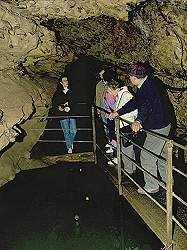
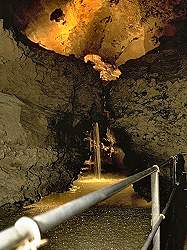
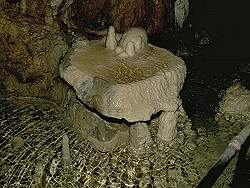
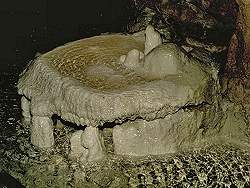
The Grottes préhistoriques d’Azé (Prehistoric Caves of Azé) were named after the nearby village of Azé, they are located close to the village at the foot of a limestone hill. In this case the plural in the name is legitimate, as there are seven cave entrances on the hillside. There is actually a cave system, and there are two different caves, one above the other, which are visited. The whole system has four Levels. The top level is the fossil part of the cave and has been accessible for many thousands of years. It was frequented by animals, Stone Age man, and Romans. The second and third level are very close together, sometimes the floor has collapsed, and there is only a single passage. This part of the cave system has no natural entrance, and so no remains of animals or man were found here. The third level is an active cave, which means there is a cave river. The bottom level of the cave is completely flooded, it is accessible only to cave divers. It’s easy to understand if you have a look at the painting at the wall of the forme cave entrance (see image above).
The tour starts with the uppermost level, which is entered through an iron bar gate in the huge portal, which is named the Cave de la Balme de Rochebin.
The natural entrance to the cave was open for several hundred thousand years and was frequented by animals.
So the remains of many species, including
 cave bear (Ursus spelaeus),
its predecessor Ursus Deningeri,
cave bear (Ursus spelaeus),
its predecessor Ursus Deningeri,
 Cave Lion (Pantera leo spelaea),
and hyena were found here.
A spectacular skull of a cave lion was discovered in 1985 by a young speleologist in the bear room.
At that time only ten such skulls were known.
The skull was sent to the Faculty of Sciences of Lyon for examination, after it returned in 1986 it was exhibited in the cave museum
Numerous bones of
Cave Lion (Pantera leo spelaea),
and hyena were found here.
A spectacular skull of a cave lion was discovered in 1985 by a young speleologist in the bear room.
At that time only ten such skulls were known.
The skull was sent to the Faculty of Sciences of Lyon for examination, after it returned in 1986 it was exhibited in the cave museum
Numerous bones of
 cave bears,
which were found during the excavation, were removed to museums.
Some are on display in the small museum at the ticket office.
One complete skeleton is on display in a corner of the big hall.
The skeleton is lying on the ground, the bones were ordered in the correct way but were not reassembled.
cave bears,
which were found during the excavation, were removed to museums.
Some are on display in the small museum at the ticket office.
One complete skeleton is on display in a corner of the big hall.
The skeleton is lying on the ground, the bones were ordered in the correct way but were not reassembled.
During a more recent excavation between 1982 and 1985, about 200 m inside the cave in an area of 16 m² more than 1,000 cave bear bones belonging to at least 44 individuals were found.
Also, the skull of a
 Cave Lion (Pantera leo spelaea)
and bones of Vulpus vulpus were discovered.
The bones were dated to be of late Pleistocene age by the analysis of their forms.
This was completed by an isotope dating of speleothems.
There were no speleothems in the area of the excavation, but a nice formation in some distance was dated, and it was possible to correlate it with the different layers of the excavation.
Cave Lion (Pantera leo spelaea)
and bones of Vulpus vulpus were discovered.
The bones were dated to be of late Pleistocene age by the analysis of their forms.
This was completed by an isotope dating of speleothems.
There were no speleothems in the area of the excavation, but a nice formation in some distance was dated, and it was possible to correlate it with the different layers of the excavation.
The excavations are still ongoing and numerous interesting palaeontological discoveries were made during the last years. A side passage was discovered and partly excavated which contained six different levels bearing fossils.
The hunters of the Ice Age lived here repeatedly and left tools and drawings. The human remains of the site date from between 350,000 and 10,000 BP. The Lower Paleolithic occupation dated around 350,000 years ago is one of the earliest human occupations in Burgundy. The usage of the cave by man continued, for example, during the Bronze Age. Pottery and an archer’s armband were found, dating from the end of the Bronze Age around 950 BC. During Roman times the cave entrance was used as a storage room, which is proven by the remains of a Roman wall, built between 275 and 300. At this time, the cave floor was filled with several meters of cave sediment, containing debris, clay, animal bones and human remains. This floor was excavated during the 19th century, and many finds are now on display in the small museum at the cave entrance. But because of the excavations, the floor is now much lower and the Roman wall, once built on the floor, now hangs below the ceiling. It had to be fixed with an iron bar to prevent a collapse.
After the visit to the upper level, the tour leaves the cave through the portal and proceeds to a small door on the hillside right below.
Here the second level of the cave is entered, showing wild river passages and
 potholes.
At some point, the second and third level meet and the tour returns through the third level.
Here the visitors follow the path of the cave river most of the time.
The paths were built right above the water level and get flooded in spring.
The river vanishes into a swallow hole close to the cave exit.
At the upper entrance to the cave river, there is also a Merovingian burial hill, where they buried their dead between 650 and 680 AD.
potholes.
At some point, the second and third level meet and the tour returns through the third level.
Here the visitors follow the path of the cave river most of the time.
The paths were built right above the water level and get flooded in spring.
The river vanishes into a swallow hole close to the cave exit.
At the upper entrance to the cave river, there is also a Merovingian burial hill, where they buried their dead between 650 and 680 AD.
The final stop of the cave tour is outside. After leaving the cave from the third level, it is only a few steps to a romantic resurgence. This is where the cave river reappears, and it is also the access to the lowest level of the cave. Of course, this part of the system is accessible only for cave divers. The resurgence was modified during Gallo-Roman times, between 150 BC and 50 AD, with a dam made of wood and clay. The water was captured and transported with pipes to a Gallo-Roman settlement. On 15-SEP-1963 the cave was pumped, and so the water level was temporarily lowered, which allowed four cavers to enter the cave system. The entered the river cave through the above-mentioned swallow hole and described their discovery “It’s the metro!” The name stuck, but the cave was later accessed by an artificial entrance tunnel.
The caves are located at the outskirts of the village Azé, on the road towards Donzy. The cave entrances are located in the campground of the village, which is accessible only to campers, so there is a new ticket office, museum, and café at the road to Donzy. From here, the guide takes visitors into the premises of the campground for the tours. This sounds a bit strange, but actually its straight forward, just follow the signs to the cave entrance. The only drawback is actually that it is not possible to walk to the cave entrance without a guided tour, which is possible at most other caves. The ticket office and museum at the road is actually quite new, ten years ago the ticket office was where now the office of the campground is located.
The cave was opened to the public in 1963 by the non-profit association Société des Grottes d’Azé. They operated the cave until 2001, when the increased costs and new security regulations were not manageable any more. As a result, the Saône-et-Loire Departmental Council took over. They made numerous alterations, including the construction of a new entrance building. For some years now they offer wine tours in the cave, which combine wine growing and geology. The tour includes the tasting of three different wines from the area.
The cave now has online booking, and it is mandatory to book tickets in advance. Be at the ticket office 15 minutes before the tour. This, unfortunately, also means that there are no open hours any more, because they make no sense any more. In other words, the open hours we give above are just an estimation, see the online booking system for the actual tours. We are not sure if this is a result of the Corona pandemic or the modernization with construction of the new entrance building. The people at the ticket office speak english. The tours are held in French, but there are audioguides in different languages. The audioguide is also available in French for the hearing impaired. The cave is closed during winter, the beginning and end of the season seems to be influenced by school holidays and thus differs slightly from year to year.
The pictures on this page are from a visit in the 1980s and are a little outdated, also the description of the tour is from that time. As far as we understand, the tour now shows the river cave first and the archaeological cave second.
- See also
 The Cave Bear
The Cave Bear Bears’ Caves
Bears’ Caves Search DuckDuckGo for "Grotte d’Azé"
Search DuckDuckGo for "Grotte d’Azé" Google Earth Placemark
Google Earth Placemark OpenStreetMap
OpenStreetMap Grottes d’Azé - Wikipedia (visited: 09-JAN-2024)
Grottes d’Azé - Wikipedia (visited: 09-JAN-2024) Grottes d’Azé, official website
Grottes d’Azé, official website  (visited: 09-JAN-2024)
(visited: 09-JAN-2024) Grottes d’AZE - FFTS (visited: 09-JAN-2024)
Grottes d’AZE - FFTS (visited: 09-JAN-2024) Caves of Azé (visited: 09-JAN-2024)
Caves of Azé (visited: 09-JAN-2024) Grottes d’Azé (visited: 09-JAN-2024)
Grottes d’Azé (visited: 09-JAN-2024)
 Index
Index Hierarchical
Hierarchical Countries
Countries Maps
Maps